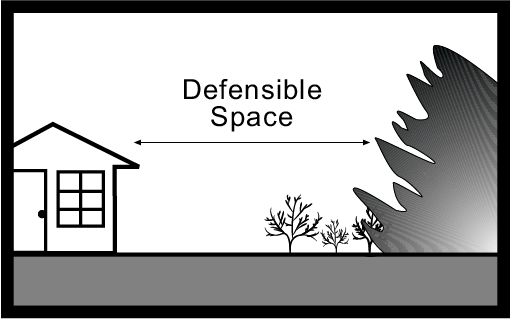Living With Fire: A Guide for Mississippi Homeowners
More than 18 million acres of Mississippi are covered with forestland. About half of this acreage is either pine or a pine/hardwood mix. Located within these pine and pine/hardwood forests are many houses, subdivisions, and communities. As more people move to and build within these forests, the chance of loss or damage from wildfire increases. While large wildfires are uncommon in Mississippi, the conditions for such fires do occur. Many homeowners living in these areas are unaware and unprepared for a wildfire. Since it is not a question of “if” but rather “when” a wildfire will occur, the likelihood of human and property loss is great and constantly growing.
Being able to live safely with fire depends on things you do before a wildfire occurs. These pre-fire actions will not fireproof your home or forests, but they will increase the likelihood of escaping both personal injury and property damage. This publication provides information on the fire environment in which we live, as well as pre-fire actions you can take to protect your home and property from wildfire damage.
The Fire Environment
Fire environment can be defined by surrounding conditions and influences that determine wildfire behavior. Firefighters recognize three parts of the fire environment: weather, topography, and fuels.
Weather includes wind, rain, temperature, relative humidity, and clouds. Weather directly affects wildfire by influencing how wet or dry a fuel is, whether a fire will start, and the speed and direction the fire moves. Another part of assessing the fire environment is the “lay of the land,” or its topography. This includes both slope and terrain, as well as bodies of water across the landscape. All of these will affect the amount and type of fuels present, as well as how fast and in what direction fire spreads.
Fuels are anything that will burn, including leaves, grasses and weeds, downed woody materials like branches and tree trunks, living shrubs and trees, manmade debris across the landscape, and even structures like houses. Houses and other buildings become a source of fuel when fires occur. The amount, size, shape, composition, distribution, and moisture content of fuels will affect fire behavior.
Together, weather, topography, and fuel affect the likelihood of a fire, the speed and direction it will travel, the intensity at which it will burn, and the ability to control and extinguish it. You cannot change weather and topography, but you can control the threat of wildfire through fuel management.
Defensible Space
Defensible space is the area between a house or other structure and an oncoming wildfire. You can change plant cover in this space to reduce the threat of wildfire and to help firefighters defend your house. Bare ground surrounding your home is not necessary. Well maintained grass, shrubs, and trees can effectively reduce the threat of wildfire, while maintaining the appearance of the home.

For the most part, you can create defensible space yourself. Watering your lawn, pruning shrubs and trees, selecting appropriate plants, and providing irrigation will help keep plants green and healthy. Tools needed for these activities are simple items found around most homes: saws, water hoses, rakes, pruning shears, and shovels.
Six Steps to Creating an Effective Defensible Space
Adapted from Carree et al., 1998, and P. Slack, (n.d.).
Step 1: Determine the slope and vegetative cover of your land.
The amount of defensible space you need for your property varies depending on slope of the landscape and vegetation present. The steeper the slope, the faster a fire can spread and the larger defensible space you need. Also, vegetation will affect how a fire burns and the amount of defensible space needed. Table 1 lists defensible space recommendations based on percent slopes and common vegetation types in Mississippi.
These recommendations are based on suggestions made by firefighters experienced in protecting homes from wildfire. They are not requirements and do not take precedence over local ordinances.
|
Vegetation type |
Flat to gently sloping (0–20%) |
Moderately steep (21–40%) |
|---|---|---|
|
Grass |
30 |
100 |
|
Shrubs |
100 |
200 |
|
Trees |
30 |
100 |
Step 2: Remove dead vegetation.
Dead vegetation includes dead trees and branches lying on or close to the ground, dried grass, dropped leaves and needles, and stacks of firewood. In most instances, dead vegetation should be removed from defensible space areas. Table 2 describes the types of dead vegetation you’re likely to encounter and recommended actions.
|
Dead fuel type |
Recommended practices |
|---|---|
|
Standing, dead trees |
Remove all standing, dead trees from within the defensible space area. |
|
Downed, dead trees |
Remove all downed, dead trees within the defensible space if they have recently fallen and are not embedded in the ground. Downed trees that are embedded and cannot be removed without soil disturbance should be left in place. Remove all exposed branches from embedded, downed trees. |
|
Dead shrubs |
Remove all dead shrubs from the defensible space area. |
|
Dried grasses |
Once grasses have dried out (cured), remove from the defensible space area. |
|
Dead needles, leaves, branches, and cones (on the ground) |
Reduce thick layers of pine needles to a depth of 2 inches or less. Do not remove all needles. Take care not to disturb the duff layer (dark area at the ground surface where needles are decomposing), if present. Remove dead cones, twigs, leaves, and branches. |
|
Dead needles, leaves, branches, and cones (other than on the ground) |
Remove all dead leaves, branches, twigs, and needles still attached to living trees and shrubs to a height of 15 feet above the ground. Routinely remove all debris that accumulates on roofs and in rain gutters. |
|
Firewood and other combustible debris |
Locate firewood and other combustible debris (wood scraps, grass clippings, leaf piles, and such) at least 30 feet away and uphill, if possible, from the house. |
Step 3: Break up continuous vegetation.
Sometimes wildland and landscaped plants grow as an uninterrupted layer instead of being patchy or widely spaced. The more continuous and dense the vegetation, the greater the threat of wildfire. If this condition is present in your defensible space, you should “break it up” by creating a separation between plants or small groups of plants.
Step 4: Remove “ladder fuels.”
Vegetation often grows and/or accumulates at varying heights, similar to the rungs of a ladder. This is common in loblolly pine plantations, where dead lower branches become draped with pine needles. Under these conditions, flames from fuels burning at ground level can be carried higher up the tree through these ladder fuels. Vegetation that lets fire move from lower areas to higher ones (from a surface fire to igniting the crown of the tree) is called “ladder fuel.” You can correct this problem by removing those ladder fuels.
Within a defensible space, a vertical separation of three times the height of the lower fuel layer is recommended. For example, if a shrub growing close to a pine tree is 3 feet tall, the recommended distance between the shrub and the lowest limbs on the tree would be 9 feet. You can achieve this separation by pruning lower tree branches.
Step 5: Maintain at least 30 feet around your house that is lean, clean, and green.
The area immediately next to your house is very important in creating an effective defensible space. It is also an area that people typically landscape. Within an area at least 30 feet adjacent to the house, vegetation should be kept:
Lean: Small amounts of flammable vegetation.
Clean: No accumulation of dead vegetation or other flammable debris.
Green: Plants that are healthy and green during the fire season are less likely to burn.
Step 6: Maintain vegetation within your defensible space.
Maintaining your defensible space is a continual process and key to keeping your fire-prevention efforts effective. At least once a year, review these defensible space procedures and take appropriate actions.
Other Ways to Protect Your Home from Wildfire
Keep these additional considerations in mind:
The roof: Remove dead branches overhanging the roof. Remove any branches within 15 feet of your chimney. Clean all dead leaves and needles from your roof and gutters. Use nonflammable roofing materials.
Construction: Build your home at least 30 feet away from the property line. Use fire-resistant building materials. Limit the size and number of windows in your home that face large areas of vegetation. Install double- or triple-paned windows. Install sprinkler systems within the house. Do not use wooden shingles or siding on your home.
Yard: Stack wood piles at least 30 feet from all structures and clear away flammable vegetation. Locate propane tanks at least 30 feet away from all structures and keep 10 feet of clearance around them. Remove all combustible materials and other debris from your yard. Keep grass mowed and green.
Emergency water supply: Have enough water hoses in good condition to cover your lawn. Keep an emergency water supply that meets fire department standards. If your water comes from a well, consider the option of purchasing an emergency generator to operate the pump during a power failure.
Access: Identify exit routes from your neighborhood. Build roads wide enough for two-way traffic and emergency vehicles. Make sure dead end roads and driveways have enough turn-around space for emergency vehicles. Clear flammable materials and debris at least 10 feet from all roads and driveways. Make sure your street is named or numbered and that street signs are visibly posted at all intersections. Make sure your house and street number are not duplicated anywhere within your county. Post your house address at the beginning of your driveway or on your house if your house is clearly visible from the road.
Outside: Designate an emergency meeting place in a safe area outside your home and practice emergency drills. Keep electric service lines, fuse boxes, and circuit breakers maintained to code.
What to Do When a Wildfire Approaches
If your home is threatened by wildfire, you may be advised to evacuate by fire or law enforcement personnel. This recommendation is meant to protect your life and should be carefully considered. However, you can stay on your property so long as you do not hinder firefighting efforts.
Conclusions
Life in southern forests is enjoyable, but it is not without danger. Even though wildfires are not common in Mississippi, they should be planned for and not dismissed. Some counties may have ordinances addressing defensible space. Check with your local planning and zoning department for further information. Taking precautions to protect your property will increase your chances of escaping serious damage and potential personal injury or death in the event of a wildfire.
For More Information
The following references were used in the development of this publication. They provide a wealth of information concerning ways to protect your home from wildfire.
Carree, Y., Schnepf, C. & W. M. Colt. 1998. Landscaping for wildfire protection. University of Idaho, Forest, Wildlife, and Range Experiment Station. Station Bulletin 67. 15p.
Firewise. Retrieved from https://www.nfpa.org/Public-Education/Fire-causes-and-risks/Wildfire/Firewise-USA
Living with fire: A guide for the homeowner. 2007. University of Nevada Cooperative Extension.
Slack, P. Firewise construction: Design and materials. Colorado State Forest Service and Federal Emergency Management Agency. 38p.
Publication 2315 (POD-10-21)
Revised by A. Brady Self, PhD, Associate Extension Professor, Forestry, from an earlier edition by Andrew J. Londo, former Extension Professor, Forestry.
The Mississippi State University Extension Service is working to ensure all web content is accessible to all users. If you need assistance accessing any of our content, please email the webteam or call 662-325-2262.




